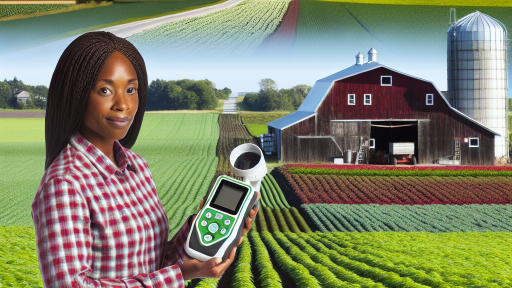Understanding Farm-To-Table Legislation
Overview of Farm-To-Table Legislation
Farm-to-table legislation focuses on increasing the supply of local foods.
This movement encourages consumers to buy directly from farmers.
It aims to reduce the distance food travels from farm to consumer.
Consequently, it fosters a healthier food economy.
Key Requirements
Farm-to-table programs feature specific regulatory requirements.
First, they often promote organic farming practices.
Second, produce must originate from certified local sources.
Moreover, transparency in food sourcing is crucial.
Finally, businesses must maintain accurate records of their suppliers.
Implications for Farmers and Restaurants
These regulations impact farmers by increasing local market opportunities.
Farmers must adapt their practices to comply with the legislation.
Additionally, restaurants need to source ingredients from local suppliers.
This often results in menu changes based on seasonal availability.
Consequently, they can enhance their appeal to health-conscious consumers.
Benefits of Compliance
Compliance with farm-to-table legislation brings several advantages.
Transform Your Agribusiness
Unlock your farm's potential with expert advice tailored to your needs. Get actionable steps that drive real results.
Get StartedBusinesses can build stronger relationships with local producers.
Furthermore, they contribute to the local economy by supporting farmers.
It also enhances their brand image by promoting sustainability.
Overall, compliance can lead to increased customer loyalty.
Challenges in Implementation
While beneficial, compliance presents specific challenges.
Farmers may face difficulties in meeting organic certification standards.
Restaurants need to establish reliable supply chains.
This may involve collaborating with multiple local producers.
Additionally, fluctuating seasonal availability can complicate menu planning.
The Role of Compliance in Modern Farming Practices
Understanding Compliance
Compliance is essential for maintaining food safety standards.
It ensures that farming practices meet regulatory requirements.
Moreover, compliance protects consumers and promotes trust.
Farmers must stay informed about relevant laws and regulations.
Importance of Compliance Strategies
Effective compliance strategies minimize legal risks.
They also enhance operational efficiency and build reputation.
In addition, these strategies promote sustainable farming practices.
Farmers gain a competitive advantage by adhering to regulations.
Key Compliance Areas in Farming
Food safety is a top priority in compliance efforts.
Water usage and management are also crucial for compliance.
Additionally, pesticide application must follow strict guidelines.
Record-keeping is vital for demonstrating compliance efforts.
Collaboration for Enhanced Compliance
Collaboration between farmers and regulatory agencies is key.
Working together ensures everyone understands compliance standards.
Furthermore, sharing best practices can elevate industry standards.
Showcase Your Farming Business
Publish your professional farming services profile on our blog for a one-time fee of $200 and reach a dedicated audience of farmers and agribusiness owners.
Publish Your ProfilePartnerships with local organizations can provide additional support.
Training and Education on Compliance
Training programs are essential for effective compliance implementation.
These programs educate farmers about current regulations.
Regular training helps maintain a culture of compliance.
In addition, workshops can address emerging compliance issues.
Developing Effective Record-Keeping Systems for Traceability
The Importance of Traceability
Traceability is crucial in today’s agricultural landscape.
It ensures transparency throughout the supply chain.
Consumers demand to know where their food comes from.
Traceability helps in identifying sources of contamination.
Moreover, it builds trust between consumers and producers.
Implementing Robust Record-Keeping Systems
Producers should start by choosing a suitable software platform.
This platform should be user-friendly and accessible.
Next, farmers need to collect data on all aspects of production.
They should track inputs such as seeds, fertilizers, and pesticides.
Additionally, capturing harvest data is essential.
Always include details about processing and distribution.
Utilizing Technology for Enhanced Tracking
Integrating technology can simplify data collection and management.
Mobile apps allow real-time data entry in the field.
Barcoding and RFID tags facilitate efficient tracking of products.
Farm management software can automate record-keeping processes.
These tools reduce the chances of human error significantly.
Training Staff and Stakeholders
All staff members should receive comprehensive training.
Training ensures consistency in data entry practices.
Stakeholders should understand the importance of traceability.
Regular workshops can reinforce best practices in record-keeping.
Regular Audits and Reviews
Conducting audits helps maintain system integrity.
Farmers should schedule regular reviews of their records.
These audits identify gaps and improve the overall system.
Furthermore, they prepare farms for compliance inspections.
Adapting to New Regulations
Compliance with changing regulations is vital.
Farmers should stay informed about local and national policies.
Their systems must adapt to meet evolving standards.
Regular updates to record-keeping practices ensure ongoing compliance.
See Related Content: Comprehensive Guide to Rural Development Policies for Farmers
Best Practices for Implementing Food Safety Standards on Farms
Understanding Food Safety Regulations
Farmers must familiarize themselves with local and federal food safety regulations.
This knowledge ensures compliance and protects consumer health.
Moreover, staying updated on changing laws is crucial for ongoing compliance.
Establishing a Food Safety Plan
A comprehensive food safety plan is essential for all farms.
This plan should outline procedures for handling, processing, and storing food safely.
Additionally, it should include employee training protocols.
Showcase Your Farming Business
Publish your professional farming services profile on our blog for a one-time fee of $200 and reach a dedicated audience of farmers and agribusiness owners.
Publish Your ProfileKey Components of a Food Safety Plan
- Risk assessment and management practices.
- Personal hygiene standards for all staff.
- Thorough record-keeping procedures.
Implementing Best Practices in the Field
Farmers should adopt best practices to reduce food safety risks.
For instance, they must regularly inspect equipment and facilities.
Furthermore, maintaining cleanliness in all areas of food production is vital.
Monitoring Practices
- Regularly test water quality used for irrigation and washing.
- Implement a schedule for sanitizing surfaces and equipment.
- Ensure proper waste management on the farm.
Training and Education of Staff
Training employees in food safety protocols is essential for success.
Regular training boosts awareness and adherence to safety standards.
Moreover, ongoing education helps staff stay updated on new regulations.
Training Techniques
- Conducting regular workshops and seminars.
- Utilizing online courses for flexibility in learning.
- Providing easy access to resources and guidelines.
Engaging with the Community
Farmers should actively participate in community discussions about food safety.
This engagement fosters transparency and builds consumer trust.
Additionally, collaboration with local farming organizations can provide valuable resources.
Community Building Activities
- Participating in local farmer’s markets.
- Hosting open farm days for community education.
- Sharing success stories and challenges faced by local farms.
Gain More Insights: Understanding Import Export Tariffs And Their Impact On Farming
Collaborating with Local Health Departments and Regulatory Agencies
Building Strong Relationships
Establishing strong relationships is crucial in modern farming.
Local health departments play a vital role in food safety regulations.
Engaging with them fosters trust and transparency.
This collaboration can enhance compliance efforts significantly.
Moreover, regular communication helps farmers stay informed about regulations.
Understanding Local Regulations
It is essential to understand local farming regulations thoroughly.
Each jurisdiction may have unique requirements for food safety.
Reviewing these regulations can help prevent compliance issues.
Furthermore, attending workshops or training sessions is beneficial.
These opportunities provide valuable insights from regulatory experts.
Participating in Local Food Networks
Joining local food networks can support compliance efforts.
These networks often include farmers, distributors, and health officials.
Participation creates opportunities for knowledge sharing and collaboration.
Additionally, networking enhances visibility within the community.
Promoting Compliance Among Peers
Encouraging compliance is a shared responsibility among farmers.
Organizing regular meetings can help discuss compliance challenges.
Sharing best practices builds a culture of accountability.
As a result, collective efforts can lead to improved compliance rates.
Utilizing Technology for Compliance Monitoring
Technology can streamline compliance monitoring efforts.
Utilizing software tools can help track regulatory changes.
Additionally, digital documentation reduces paper clutter and improves accuracy.
Farmers can share data easily with health departments through these platforms.
Implementing these tech solutions can enhance overall efficiency.
Learn More: Best Practices For Conservation Program Success

Conducting Training Programs for Farm Workers on Compliance Procedures
Importance of Training Programs
Training programs enhance worker knowledge about compliance procedures.
Such programs reduce risks related to regulatory oversight.
Workers who are well-trained are more likely to follow guidelines.
Components of an Effective Training Program
An effective training program includes various components.
First, it should have clear objectives and goals.
Next, it should provide practical demonstrations of procedures.
Showcase Your Farming Business
Publish your professional farming services profile on our blog for a one-time fee of $200 and reach a dedicated audience of farmers and agribusiness owners.
Publish Your ProfileAdditionally, it should incorporate visual aids to enhance understanding.
Lastly, regular assessments ensure knowledge retention.
Delivery Methods for Training Programs
Different delivery methods can be utilized for training.
In-person workshops foster hands-on learning and engagement.
Online courses offer flexibility and can reach remote workers.
Additionally, on-the-job training reinforces learning in real scenarios.
Creating a Positive Learning Environment
A positive learning environment encourages participation.
It is essential to foster open communication among workers.
Moreover, recognizing and rewarding achievements can motivate others.
Evaluating Training Effectiveness
Evaluating the effectiveness of training programs is critical.
Feedback should be collected from participants regularly.
Metrics such as compliance rates can help assess improvements.
Adjustments should be made based on evaluations to enhance future trainings.
Discover More: Enhancing Food Quality Through Farm-To-Table Regulations in Farming
Utilizing Technology and Software for Compliance Management
Introduction to Compliance Technology
Compliance technology plays a crucial role in modern farming.
It streamlines the monitoring process for farm-to-table regulations.
Moreover, it enhances transparency in agricultural practices.
Types of Compliance Software
Farm management software helps track production data effectively.
Traceability systems ensure that products can be tracked from farm to table.
Additionally, quality management software assists in maintaining high standards.
Benefits of Implementing Compliance Tools
Utilizing compliance tools reduces the risk of regulatory violations.
They also save time and resources compared to manual processes.
Furthermore, these tools improve data accuracy and reporting efficiency.
Integrating Technology into Daily Operations
Farmers should adopt mobile applications for real-time compliance checks.
Using cloud-based systems allows for easy data sharing and access.
Moreover, training staff on these technologies enhances overall compliance.
Advanced Technology for Compliance Management
Incorporating advanced technology is essential for effective compliance management.
It positions farmers to respond better to evolving regulations.
Evaluating and Adapting Compliance Strategies
Case Study: Green Valley Farms
Green Valley Farms successfully adapted to new regulations.
They implemented rigorous record-keeping systems.
This allowed them to track produce from farm to table.
Moreover, they established partnerships with local restaurants.
This enhanced their market reach and compliance.
Case Study: Riverstone Organics
Riverstone Organics focused on organic certification.
This shift improved their farm’s compliance status.
Additionally, they educated consumers on the benefits of local foods.
Through community workshops, they built a loyal customer base.
Strategies for Small Farms
Small farms can utilize cooperative models for compliance.
Joining cooperatives offers shared resources and knowledge.
Additionally, local outreach helps raise consumer awareness.
Showcase Your Farming Business
Publish your professional farming services profile on our blog for a one-time fee of $200 and reach a dedicated audience of farmers and agribusiness owners.
Publish Your ProfileUsing social media can connect producers with buyers.
Adapting to Regulatory Changes
Staying informed is crucial for all farms.
Regularly reviewing local regulations helps maintain compliance.
Farmers can attend workshops to better understand changes.
This proactive approach minimizes potential issues down the line.
Best Practices for Compliance
- Maintain detailed records of production and sales.
- Engage with local regulatory bodies for guidance.
- Participate in training programs on compliance standards.
Following these best practices strengthens compliance efforts.
It ensures that farms thrive within regulatory frameworks.
Additional Resources
CAP 2023-27 – European Commission
Handy Reference Guide to the Fair Labor Standards Act | U.S. …




